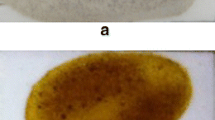Abstract.
Lustre was one of the most sophisticated techniques for the decoration of majolicas during the Renaissance period. Lustre consists of a thin metallic film containing silver, copper and other substances like iron oxide and cinnabar applied in a reducing atmosphere on a previously glazed ceramic. In this way, beautiful iridescent reflections of different colours (in particular gold and ruby-red) are obtained. The characterisation and the study of lustre-decorated majolicas is of great interest for archaeologists, but also offers possibilities for producing pottery with outstanding decoration today, following ancient examples, since nowadays Italian artisans are interested in the reproduction of the ancient recipes and procedures. Moreover, it can even suggest new procedures for obtaining uniform thin metallic films for technological applications. A study has been carried out on ancient lustre layers using numerous different analytical techniques such as XRD, SEM–EDX, TEM–EDX–SAED, ETAAS, ICP–OES, UV–vis reflectance spectroscopy and SAXS. Lustre films were shown to be formed by copper and silver clusters of nanometric dimension. The colour and the properties of the lustre films depend on the elemental composition of the impasto applied to the ceramic surface as well as on other factors like the metallic nanocluster dimension, the firing conditions, the underlying glaze composition and the procedure used.
Similar content being viewed by others
Author information
Authors and Affiliations
Additional information
Received: 12 August 2002 / Accepted: 14 August 2002 / Published online: 8 January 2003
RID="*"
ID="*"Corresponding author. Fax: +39-6/9067-2445, E-mail: pad@mlib.cnr.it
Rights and permissions
About this article
Cite this article
Padeletti, G., Fermo, P. How the masters in Umbria, Italy, generated and used nanoparticles in art fabrication during the Renaissance period . Appl Phys A 76, 515–525 (2003). https://doi.org/10.1007/s00339-002-1935-1
Issue Date:
DOI: https://doi.org/10.1007/s00339-002-1935-1




